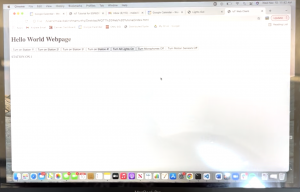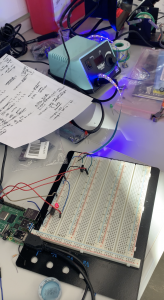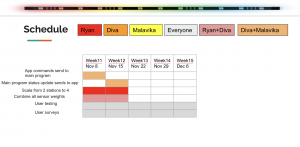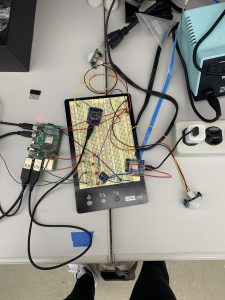Week 9:(Group) This week we have two working base stations. We are able to send messages from the base station to the web app and from the web app to the base station. We also go the lights to turn on by using transistors.
The messages we are able to send from the web app to the raspberry pi base station are the following:
STATION:ON/OFF:Station Number
Station Number (1,2,3,4 or 5 (all stations))
On – force station to remain on regardless of the sensor data
Off – go back to just working with the sensor data
MICS:ON/OFF
On – use mic data
Off – ignore mic data
PIRS:ON/OFF
On – use pir data
Off – ignore pir data
WEIGHT:AUTO/Manual:PIR weight:Mic weight
This is the only one not yet implemented
It allows the user to set the weight of pir data and mic data manual if they wish too
The messages we are able to send from the raspberry pi base station to the web app are the following:
STATION:ON/OFF:Station Number
Station Number (1,2,3,4)
This message is sent from the raspberry pi base station to the web app when a station on/off state changes.
WEIGHT:AUTO/Manual:PIR weight:Mic weight
This is the only one not yet implemented
Send the current weights of pir and mic data either when prompted or when changed.


This is our current plan for the remaining weeks:

Week 8:(Group) This week we were preparing for the interim demo. We go the web app communicating with the raspberry pi base station, we got a base station setup with a led to mimic the lights for the base station, we integrated sensor data into the base station script written last week, and we finalize on the microphones we want to use (the digital output, with a potentiometer to manage threshold).
Week 7:(Group)This week we made progress on getting sensor values from multiple microcontrollers. We need to work on distinguishing between microcontrollers next week.  We made progress on the webapp by taking into consideration the remarks made during our last meeting to make the webapp more essential to the project. One potential way of doing that is providing privacy settings on the apps that can do things such as turn off the microphones and just use the PIRs. We also have working base station code that implements the two following diagrams, using simulated sensor inputs:
We made progress on the webapp by taking into consideration the remarks made during our last meeting to make the webapp more essential to the project. One potential way of doing that is providing privacy settings on the apps that can do things such as turn off the microphones and just use the PIRs. We also have working base station code that implements the two following diagrams, using simulated sensor inputs: 

Week 6:(Group) This week we got started working on the webapp, got the microcontrollers and raspberry pi connected to the cmu wifi, and we got testing done for the new microphones. We also discussed various ethical concerns and have looked at modifying our design accordingly.
Week 5:(Group) This week we spend a lot of time focusing on our Design Report, which helped us also flush out and update our software design. We also accomplished a lot of preliminary testing with our PIR sensors. This preliminary testing helped us update our design. The PIR sensor data was not surprising however did help us solidify our previous hypothesis. This is some of the data we collected and photos of us testing. We worked with different ranges for the PIR sensors, different positions on the work area, and different angles.






Week 4:(Group) This week we had our Design Proposal Presentation. We started writing our Design Proposal Report. We also set up our PIR sensors to work with our wifi microcontrollers. We are still waiting on some of our other parts. We also collectively continued researching and thinking through various signal weighing strategies.
Week 3: (Group) This week we all met with Professor Yu and our assigned TA Edward to discuss more specific design and implementation decisions we made. We refined our design choice by including more PIR sensors at different locations of our lab area use case to maximize range and coverage while minimizing overlap. We also researched different projects that have tried to combine sensor data from multiple sources to maximize the accuracy and confidence of our measurements when localizing signals to identify an individual in a room. We also received most of our project parts, and Ryan and Diva will begin testing sensor data so we can start formalizing the PIR sensor logic for our solution approach. We also began working on the design review presentation for Monday.
Week 2: (Group) This week Diva presented our Project Proposal presentation. We received a lot of feedback from our peers and will be taking their constructive criticisms into consideration for our final iteration of the project. We also placed an order request for the parts of our project including the LED lights, microphones, sensors, etc. Malavika has also started to research ways to allow mobile applications to interact with Raspberry Pis.
